Water From Air? Facing Drought, County Board Of Supervisors Considers High Tech Pilot
Water has always been a driving issue in California. And with the worst drought in recorded history getting to be a real possibility for 2014, California counties and cities are looking at every possible strategy for ensuring stable water supplies.
Recycling wastewater for industrial and landscaping uses is one method for conserving the drinking water supply. And for more than a decade, Santa Clara has actively promoted recycled water services in the city, with Great America, Intel, and Santa Clara University among its best customers.
The next step is further purifying that wastewater for use as drinking water – direct potable reuse. In 2009, San Diego launched a pilot study and the 2012 results showed that the purified water approached distilled water quality. Closer to home, Sunnyvale is considering a plan to have a direct potable reuse system operating by 2021, according to a report last week in SanJoseInside.com.
Last week the Santa Clara County Board of Supervisors asked the county staff to consider the feasibility of a pilot project of a very new technology for shoring up the county’s water supply: Adiabatic Distillation.
In plain English, that means making drinking water from humidity in the air. The process replicates the natural condensation of moisture from the air by simulating the dew point and then purifying the water. The Supervisors’ agenda noted that the technique has been used in Florida for agriculture.
“Emerging technologies are difficult to implement as there is no proven rack record of the their efficacy,” wrote Supervisor Dave Cortese, who is sponsoring the project. “The county should be as innovative as any in Silicon Valley [in] finding new ways to address potential natural disasters.”
One company that makes this technology, Skywater, says that its systems have been used successfully in disaster relief in the Philippines and Haiti. The company also makes a home and office water-cooler size device that costs about $2,500.
County Considers a Joint Powers Authority to Address Housing Crisis and Homelessness
At its Mar. 11 meeting, the Board of Supervisors also considered the advisability of creating a Housing Joint Powers Authority to address affordable housing needs and the problems of homelessness countywide. In the past, the county’s role was largely limited to authorizing contributions to the Housing Trust Fund and creating an Office of Affordable Housing. Similar JPA programs have been created in Sacramento and San Mateo Counties, and in San Diego.
One reason the county needs to address the issue is that cities have lost the redevelopment funds funded these programs in the past – the Housing Trust of Silicon Valley estimates that affordable housing funding in the area has dropped 64 percent from 2008 to 2013.
Another impetus is the growing number of homeless households – now over 7,600. Further exacerbating the problem, the criminal justice realignment is putting more people into the community who are leaving prison with few resources, and certainly not enough to pay average area rents.
In addition, a regional approach makes sense for several reasons, according to the agenda report. First, people whose housing is precarious, often move frequently – making that population difficult to serve in a single city. Second, a countywide service can leverage the combined resources of the entire county, streamline services, and reduce overhead.
Rather than seeing housing instability and homelessness as the problem to be solved, the proposed agency would consider housing as, essentially, an intervention that’s needed to stabilize at-risk individuals and families. And it’s one that would reduce the cost of crisis care, as well as fostering family stability – something that we know reduces the cost of public services in the long term.
To fund this program, the Supervisors estimate that there is $5.4 million in one-time state and county funds, and an additional ongoing $4 million in county funds over a 10-year period. The Board has committed 20 percent of RDA shutdown funds that are returned to the county, if the cities make the same commitment from their share of the RDA money (about 10 percent).
Additional funding sources could include impact fees, zoning value increase recapture, sales taxes, county and developer fees, business taxes, parcel taxes, and bond sales.
A Joint Powers Authority (JPA) is a separate legal entity with a separate administrative structure that allows public entities to undertake projects, while protecting the member entities from liability, and enables bond-issuing powers without a public vote. For example, Santa Clara’s Housing, Sports and Open Space, and Stadium Authorities are JPAs.
You can view County Supervisors’ meetings video, agendas, and transcripts by visiting www.sccgov.org/sites/bos and selecting Board Webcasts. If you select “video,” you’ll see links to the transcripts, agenda packet, and minutes.











0 comments